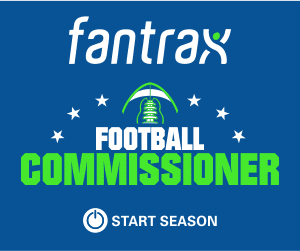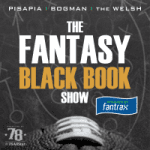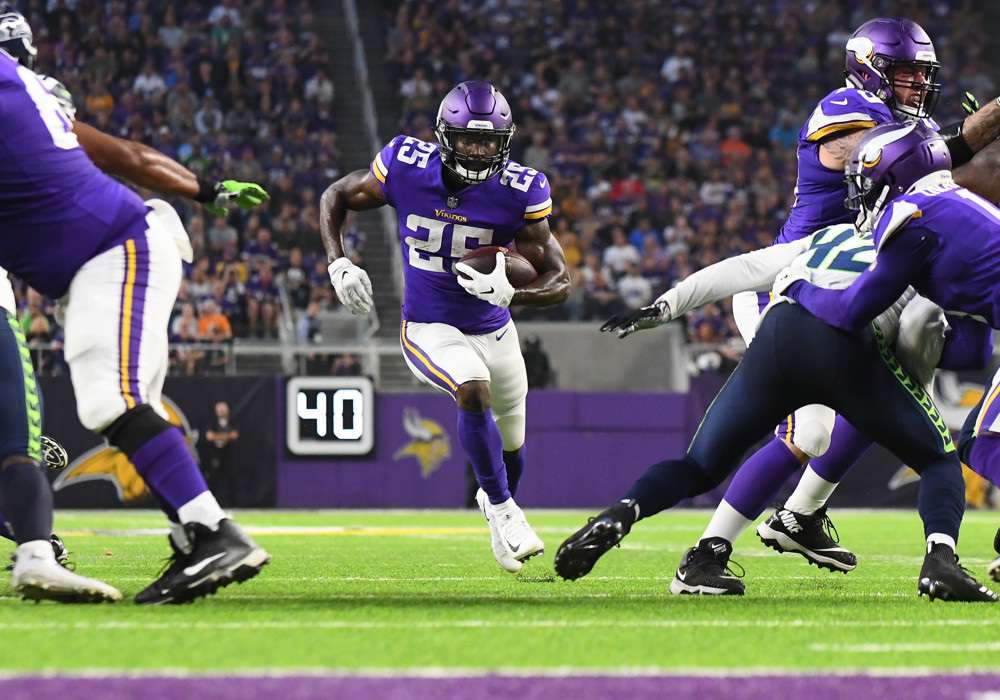Football, actual football, is set to be played in the coming weeks. Meanwhile, best ball drafts are hitting their peak. Preseason action gives drafters the confirmation bias they’ve been searching for throughout the entire offseason. The ‘coach speak’ we loathe to parse through becomes reality. One-on-one videos from camp and other highlights now have the missing piece: in-game context. Each play and each series during the preseason is met with the same scrutiny:
- Who’s working with the first team?
- Which rookie is making a name for himself?
- How many snaps did everyone receive?
Daily news and speculation. Preseason action. Injuries. Veterans still being brought in for workouts. The cycle continues, but our approach should remain the same. To help better understand dealing with best ball drafts for both 2018 and beyond, I enlisted some help.
[popup_anything id=”29077″]
The Experts
Mike Beers (@beerswater) – The 2017 Pros vs. Joes champion. Mike’s #chartsonchartsoncharts have been used by drafters to better understand the week to week value of players. You can find him running the Best Ball Command Center (#BBCC) building new tools for the community and continually trying to find an edge on best ball drafts. Mike’s collected and analyzed data from every platform available to drafters.
Dan Williamson (@OverHypedSleepr) – Dan’s been obsessing over and winning at fantasy football since 1990 in a variety of formats including high-stakes, auctions, dynasty, and of course, best ball. He jumped into best ball shortly after MFL popularized it in 2013 and has been profitable ever since. This year he has already entered 125 leagues across Fanball MFLs, Fantrax, and FFPC and is entering more leagues daily in each format.
Topics
The heavy hitters were brought in to add their thoughts to mine and create a roundtable. Topics were those pertinent to best ball rafts and the 2018 season. The general categories were:
- Draft Philosophy
- Dealing with Trends
- Player Preferences
Each was asked a set of questions pertaining to each category. The responses were collected and shown in the following sections with some of my own input.
Philosophy for Best Ball Drafts
CA: “All right, fellas. I’ll start us off with something more philosophical to get us started. Before I really understood roster construction or draft strategies, I followed the market. ADP was my guide without truly evaluating players, ranges of outcomes, or projected value/usage. Now, I do it automatically. I believe the early round doesn’t offer much wiggle room with respect to value, so it’s all about targets and touches. It’s the mid- to later rounds where I start to plant my flags and take a stand on situations. I’m no ‘projectionist’ by any means, but there are plenty of resources that can lead me to a logical conclusion.
But, what’s your general approach to best ball drafts independent of draft position? Are there specific mantras or thought processes you follow when building your teams?”
MB: My approach is to go into each draft without a specific approach. Each draft is different, based on which pick you have and what your opponents are doing. I am just looking for the best value available for the first several rounds. I let that value dictate the shape of my roster, and I will use the latter two-thirds of the draft to balance the roster construction. Also, don’t reach for the top defenses!
DW: I strive for thoughtfully constructed rosters every time, which means several things.
- Early in the draft capture as many touches and targets as you can, with prejudice towards taking those players who are tied to the best QBs or offenses.
- Don’t try to force the draft to react to how you want to build your team. Build your team based on the values the room presents to you and build the rest out from there.
- Be risk-averse in the early rounds. Some risk is fine but if you blow too many early picks your team is going to be dead in the water.
- Be sure your team meshes well together. Avoid drafting too many byes on the same week and don’t hedge bets within a team (e.g. drafting the Packers’ RBs).
- Later in drafts, embrace risk. Try to find players who already have at least a small piece of the pie in their offense right now, but who also have a logical path to a much larger role. Also, try to find the boom/bust players you hate to roster in redraft leagues. Best ball takes the decision out of your hands.
About the only mantra I stick to is to not over-expose myself to favorite players. I have a lot of confidence in my drafting ability, but I also know that none of us, including me, is particularly good at drafting over the long-term. Even if you are excellent at player and team evaluation, you can’t control for injuries and sometimes you’ll just flat-out be wrong in your evaluation for a variety of reasons.
CA: “How important is roster construction? What’s your preferred construction?
I didn’t really catch on to win-rates and how they correlate to until I joined the #BBCC. But my construction varies over the course of the offseason. I’ll look at three picks for any of the onesie positions during the early portion because we have no clarity on bye weeks. Once schedules are released, I’ll still use three on a onesie position, but only on the position where I’m the weakest. Like, say, I wait until Round 13 to draft my first quarterback. I’ll most likely take two more to compensate.”
MB: Roster construction is very important! Implementing smart roster construction doesn’t win your league but ignoring roster construction can severely handicap your team. Drafters getting the most out of every roster spot are the ones who consistently in a position to win.
DW: I think it’s the most important thing you can get right to help you boost your winning percentage. Good roster construction is mandatory to help you withstand the absolute chaos of an NFL season with no waiver wire.
I don’t have a preferred construction, but I stay within some narrow parameters for MFL and Fantrax leagues:
- 2-3 QB
- 4-6 RB
- 7-9 WR
- 2-3 TE
- 2-3 DEF
CA: “How did you decide on these limits for each position?”
Essentially how much draft capital you allocate to each position with your early picks. Some examples. If you start off a draft RB-RB-RB then you might be able to stop at 4 RBs, but certainly no more than 5. Or, if you take an early TE then stop at 2. If you take your first QB after the first dozen or so are off the board then you might want to go with a 3rd QB. More uncertainty means you should probably go heavier at the position, keeping in mind you will be going lighter in another position as a result.
 A good exercise is to build some best ball drafts backward on paper. Go thru some recent ADP, select the players you like best in each round, and then start with round 20 and work your way backward assembling a mock team. You’ll quickly see that RBs are scarce with unclear situations in the late rounds while there’s still plenty of reasonable WR choices left. You’ll also quickly see the hidden cost of selecting a defense too early. This is not an exact plan that you’ll try to follow in any given draft, but just a good way to see where the value lies and at what point you might get uncomfortable selecting players at any given position.
A good exercise is to build some best ball drafts backward on paper. Go thru some recent ADP, select the players you like best in each round, and then start with round 20 and work your way backward assembling a mock team. You’ll quickly see that RBs are scarce with unclear situations in the late rounds while there’s still plenty of reasonable WR choices left. You’ll also quickly see the hidden cost of selecting a defense too early. This is not an exact plan that you’ll try to follow in any given draft, but just a good way to see where the value lies and at what point you might get uncomfortable selecting players at any given position.
Trends in Best Ball Drafts
CA: “Every time I draft. I keep seeing so many running backs going in the first round. That’s such a departure from last year when we saw #ZeroRB getting pushed. Not being as experienced, I have found myself falling prey to the trends and taking running backs early, but I’m trying! The thing I’ve noticed is that while the trends exist, it’s important to understand positional scarcity and knowing how/when to pivot. Having a full set of rankings or tiers allows you to pinpoint targets later on in the draft when you have to make adjustments.
Are there any historical trends that drafters seem to forget every year that savvy players can exploit?”
MB: The “top” defense doesn’t pay off! Also, rounds 9-12 have been the sweet spot for quarterbacks for years. You can always count on getting a couple of solid guys there.
DW: The main trend to exploit is recency bias. Every year, drafters focus far too much on what happened the previous season even if what happened was a break from an established trend. For example, Drew Brees has perennially been a top-3 QB in fantasy but due last season his ADP this year is closer to the QB8-13 tier than it is to the QB1-4 tier. He’s often available in the 9th round in best ball drafts, which means that even if he does no better than last year, he’s not going to hurt your chances to win at all, but if he does bounce back up to top-3 then he is going to carry your team up the standings with him.
CA: “How do you handle positional runs in best ball drafts?
Personally, my first instinct is to lean into the run. It’s most likely -EV, but it is my first inclination as the fear of missing out hits me. But, again, understanding positional tiers and having my own set of rankings helps in this area. While I might have missed out on a few specific players, I’ll still most likely be able to capture similar production with my pick or a future one if I plan everything out.”
MB: I usually have players grouped into tiers, so position runs only become a concern if I am near the end of a tier. I’m generally not too concerned about them though – if people are reaching for one position, they are leaving me value at another, and I can adjust.
DW: The key is to recognize when a tier is exhausted during a run and pivot to a different position for your pick. The worst thing you can do is chase a run into the next tier. Cut your losses and just address the position in another round or two.
Player Preferences
CA: “Are there any players you find yourself constantly drafting at cost or reaching for in 2018?
I have a quite a few shares of Latavius Murray. Regardless of how we think Dalvin Cook will look when he returns, I still think Murray has stand-alone value with an even larger role should Cook have any setbacks. He has some familiarity with the new OC and his price, up until the last month, has been essentially free. ”
MB: Paul Richardson is my largest player exposure so far. I don’t love him, per se, but I love his 13th round price when he has the potential to be the top fantasy scoring receiver in Washington. I don’t think I have “planted a flag” on Jordan Howard, but I have gotten into plenty of arguments defending him, so maybe that counts!
DW: Alex Collins is probably that player for me. I think the Ravens are going to be better offensively in 2018 and Collins has a real shot at being a bell-cow RB or something close to that. He’s going at RB21 in ADP and I could easily see him finishing in the RB5-12 range.
More common for me than ‘flag-planting’ is just finding a player’s price to be irresistible. Here are a few players that I have trouble passing up at ADP:
- QB: Brees, Luck, Dalton
- RB: Collins, Devonta Freeman, Lynch
- WR: Emmanuel Sanders, Cam Meredith, Paul Richardson
- TE: Rudolph, Eifert
CA: “What about players you’re avoiding?
Dalvin Cook is an easy answer for me given my investment into Murray, but I haven’t found myself drafting Dez Bryant. There are a lot of situations I’d like to gamble on breaking in my favor, but I just don’t see how this works out regardless of what team he signs with if that ever happens. I keep thinking about Sammy Watkins and his late signing from 2017. If it works out for him, great, but I’d rather take a shot on players that have teams with workloads.”
MB: Dalvin Cook. He’s just not quite safe enough for me in the early second round, given his injury history and the strength of his backup, Latavius Murray.
DW: Here are a few players whose ADPs I just can’t stomach:
- QB: Watson, Garoppolo
- RB: Drake, Dion Lewis, Chris Thompson
- WR: Tyreek Hill, Brandin Cooks, Alshon Jeffery
- TE: Jimmy Graham, Jordan Reed, O.J. Howard
Final Thoughts
CA: “What advice would you give someone just getting into Best Ball drafts?”
MB: Read a couple of articles on roster construction to get the basics down, and then just get started! Having a “feel” for the draft is underrated, and it’s something you only get through repetition. Good luck!
CA: “…and here I would have thought you’d tell folks to join the Best Ball Command Center.”
DW: Know who you are as a player. Are you a casual player who just wants to do a few BB’s for fun or just as a sort of mock draft for your home league? Or are you planning to do dozens of best ball drafts and build a portfolio? Do you embrace risk or are you someone who would rather win a little less to minimize your chances of taking a big loss? If you’re just doing a few for fun, make sure you have fun! If you think you want to invest more into best ball leagues, then you should plan that investment wisely. Slowly ramp up the number of leagues you are drafting in, so any mistakes don’t impact all your teams.
Review each draft. Every team including yours. Find your favorite squads and note what you like about them. If you see a construction you really like from a certain draft position, mimic it as closely as you can the next time you get that draft position. Confidence is key when it comes to managing multiple drafts at once.
Don’t spend more than you can comfortably afford to lose in your first season. Assume that you will lose every league. You probably won’t if you’re reasonably good at fantasy football, but anything can happen. Remember…roster construction!
CA: “Anything else?”
If you aren’t active on Twitter, I highly suggest that you do so and start following and interacting with some of the fantasy experts and high-volume best-ball players. A lot of drafters use their Twitter handles as their team name. Go check out the leaderboard of who has done the most drafts and start following them. Post your drafts on Twitter and ask for advice.
Seek out more articles, such as this one, which addresses best-ball specifically. Read voraciously but also judiciously.
CA: “Voraciously?”
There is a lot of good advice out there on many different sites, but also a lot of bad advice. Pay attention to who the author is and their level of skill. Remember that some of the best drafters might have a very low profile, but these are the best sources of wisdom. Conversely, some very high-profile authors are not necessarily very experienced or very good in best ball drafts and can lead you astray.
CA: “I say this about anything fantasy related, but…have fun! Live drafts are a rush. Folks actually set song playlists to doing these. There’s strategy, there’s luck, there’s variance…everything any gambler would want in a game that only costs $10 to play. The industry has only grown to make the contests more entertaining with cheaper prices and bigger prizes. If you want to dabble, hop in a draft. At the very least, come to the #BBCC so you can learn from the best!”
 Ready to amp up your Fantasy Football prep even more? Check out The Fantasy Black Book Show, where Joe Pisapia, Scott Bogman, and The Welsh bring the goods every week.
Ready to amp up your Fantasy Football prep even more? Check out The Fantasy Black Book Show, where Joe Pisapia, Scott Bogman, and The Welsh bring the goods every week.

